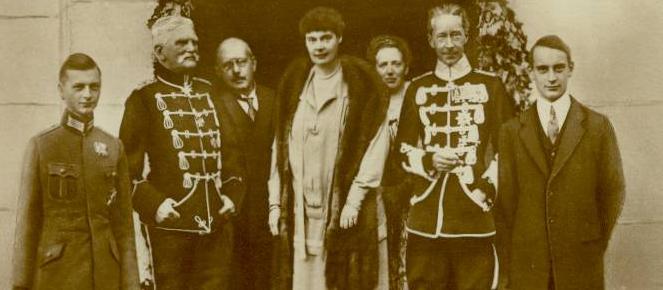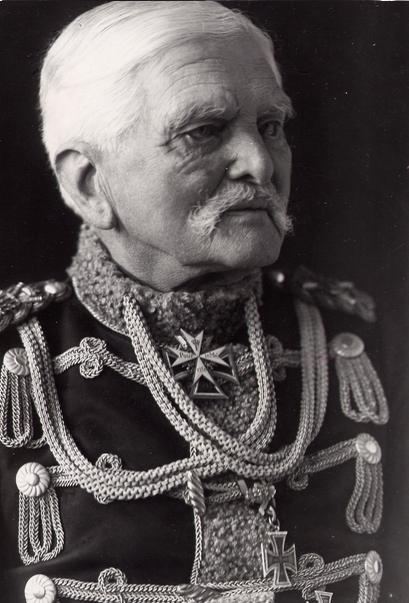August von Mackensen
From Kaiserreich
Anton Ludwig Friedrich August von Mackensen (born Anton Ludwig Friedrich August Mackensen in December, 6 1849 at Haus Leipnitz, Prussia)is a German soldier and Generalfeldmarschall. He is famous for his role in the Serbian, Romanian and Greek campaigns during the Weltkrieg, and currently holds the office of commander of German Reichsheer.
Contents |
Biography
Early years
Mackensen was born in Haus Leipnitz, near the village of Dahlenberg in the Prussian Province of Saxony, to Louis and Marie Louise Mackensen. His father sent him to a Realgymnasium in Halle in 1865, with the apparent hope that Mackensen would follow him in his profession.
Mackensen began his military service in 1869 as a volunteer with the Prussian 2nd Life Hussar Regiment During the Franco-Prussian War he was promoted to second lieutenant and recommended for the Iron Cross, Second Class. After an interlude at Halle University, Mackensen formally entered the German Army in 1873, with his old regiment. In 1891 he joined the General Staff in Berlin, where he was heavily influenced by the new chief, Alfred von Schlieffen. From June 17, 1893 to January 27, 1898, Mackensen commanded the 1st Life Hussar Regiment (1. Leib-Husaren-Regiment Nr. 1), to which he became à la suite when he left command and whose uniform he often wore as a general. He was ennobled on January 27, 1899, becoming August von Mackensen. From 1901 to 1903, he commanded the Life Hussar Brigade (Leib-Husaren-Brigade), and from 1903 to 1908 he commanded the 36th Division in Danzig. When Schlieffen retired in 1906 Mackensen was regarded by some as a possible successor, but the job went to Helmuth von Moltke the Younger. In 1908, Mackensen took command of the XVII Army Corps, and commanded this corps until shortly after the beginning of the Weltkrieg.
The Weltkrieg
|
At the beginning of the first Weltkrieg Mackensen remained in command of XVII Army Corps as part of the Eighth Army under first General Maximilian von Prittwitz and then General Paul von Hindenburg and saw action in the battles of Gumbinnen and Tannenberg. On November 2, 1914 Mackensen took command of the Ninth Army from General von Hindenburg, who had been named Supreme Commander East (Oberbefehlshaber Ost). On November 27, 1914 Mackensen was awarded the Pour le Mérite, Prussia's highest military order, for actions around Łódź and Warsaw. He commanded the Ninth Army until April 1915, when he took command of the Eleventh Army and Army Group Kiev , seeing action in Galicia, and assisting in the capture of Przemyśl and Lemberg. He was awarded oak leaves to the Pour le Mérite on June 3, 1915 and promoted to Generalfeldmarschall on June 22. After this campaign, he was awarded the Order of the Black Eagle, Prussia's highest-ranking order of knighthood. During this period, he also received numerous honors from other German states and Germany's allies, including the Grand Cross of the Military Max Joseph Order, the highest military honor of the Kingdom of Bavaria, on June 4, 1915.
Serbian Campaign
In October 1915, Mackensen, in command of the newly-formed Army Group Mackensen , which included the German 11th army, Austro-Hungarian 3rd army, and Bulgarian 1st army), led a renewed German-Austro-Hungarian-Bulgarian campaign against Serbia and finally crushed effective military resistance there but failed to destroy the Serbian army, which, though cut in half, managed to withdraw to Entente-held ports in Albania and, after recuperation and rearmament by the French, reentered fighting on the Macedonian front. Apart from his army group, the Bulgarian 2nd army also took part in the attack, commanded by a Bulgarian general. After conquering Belgrade, the troops of the Central Powers having encountered a very stiff resistance, Mackensen erected a monument to the Serbian soldiers who died heroically defending Belgrade, saying, "We fought against an army that we have heard about only in fairy tales".
Romanian Campaign
He followed this up in 1916 with a successful campaign against Romania (under the overall command of General Erich von Falkenhayn). He was in command of a multi-national army of Bulgarians, Ottoman Turks, and Germans. Despite this, his offensives were very successful, breaking every army that faced his own. On January 9, 1917, Mackensen was awarded the Grand Cross of the Iron Cross, becoming one of many recipients of this honor in the Weltkrieg. From 1917 on, Mackensen was the military governor of Romania. At this post, he destroyed the Romanian army, which had been reorganised after the Kerensky Offensive was thrown back, at the battle of Mărăşeşti.
Greek Campaign
As military governor of Romania, he was given full control of Operation Teutoberg, a combined German/Austrian/Bulgarian offensive on Greece and the Salonika bridgehead. While the Austrians and Bulgarians pinned down the allied forces at Salonika, the German divisions led by von Mackensen swept through Greece. The Feld Marschall entered in Athens on July 3rd. Returning North, the German armies drove the Allies back in to Salonika. Besieging Salonika for 5 months until the fall of the city on December 28th was the last military operation of von Mackensen during the Weltkrieg, who spent it as military governor of Romania until the German withdrawal in 1922.
Post-Weltkrieg

Considered as a staunch monarchist, even within the military circles of Germany, and a personal friend of Kaiser Wilhelm II, Feld Marschall von Mackensen came back to Germany with a particulary high prestige, as his situation is rather unusual among the German general officers, being elevated to the highest distinctions without being born an aristocrat. His appearences in official dinners dressed in his uniform of Life Hussar gave him a trademark, as well as his rabid speeches against Syndicalism. He was named in 1925, in remplacement of a too powerful Erich Ludendorff, chief of the Reichsheer, later being under the orders of his former aide, Hans von Seeckt, made Chief of Staff in 1932. A staunch conservative, von Mackensen remains an infantry and even cavalry proponent, considering tanks or planes as useless toys. Despite his alleged links with Pan-Germanist and paramilitary organizations, he stays loyal to the Hohenzollern dynasty.
Personal life
Von Mackensen married on November 21st 1879, with the daughter of a high magistrate, first president of the province of Prussia, Miss Dorothée von Horn, sister of the lieutenant von Horn, fallen during the campaign of France and regimental friend of the future marshal. This alliance helped him in its social ascension. The Mackensen household had three sons and two girls. Two of the boys chose the army. Eberhard remained there, but Georges passed in the diplomacy and Manfred in the civil service. The eldest daughter died and the last been born in 1897, dedicated herself to charity. Their mother died at Dantzig on December 4, 1905, and the general married in second wedding Léonie, daughter of count von der Osten, belonging to the first nobility. She also died on May 7, 1916.
His son Hans Georges is the current German ambassador in Budapest,Austria-Hungary, while his other son Eberhard is currently colonel and chief of staff the X Army Corps.


